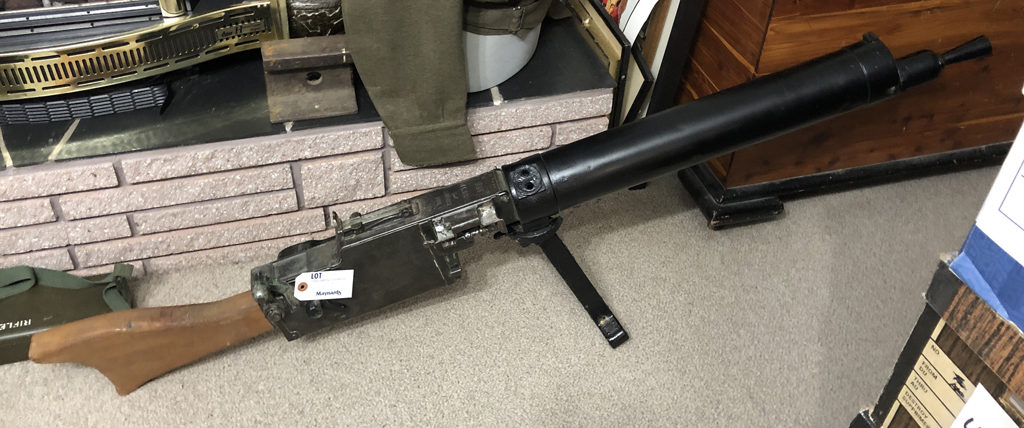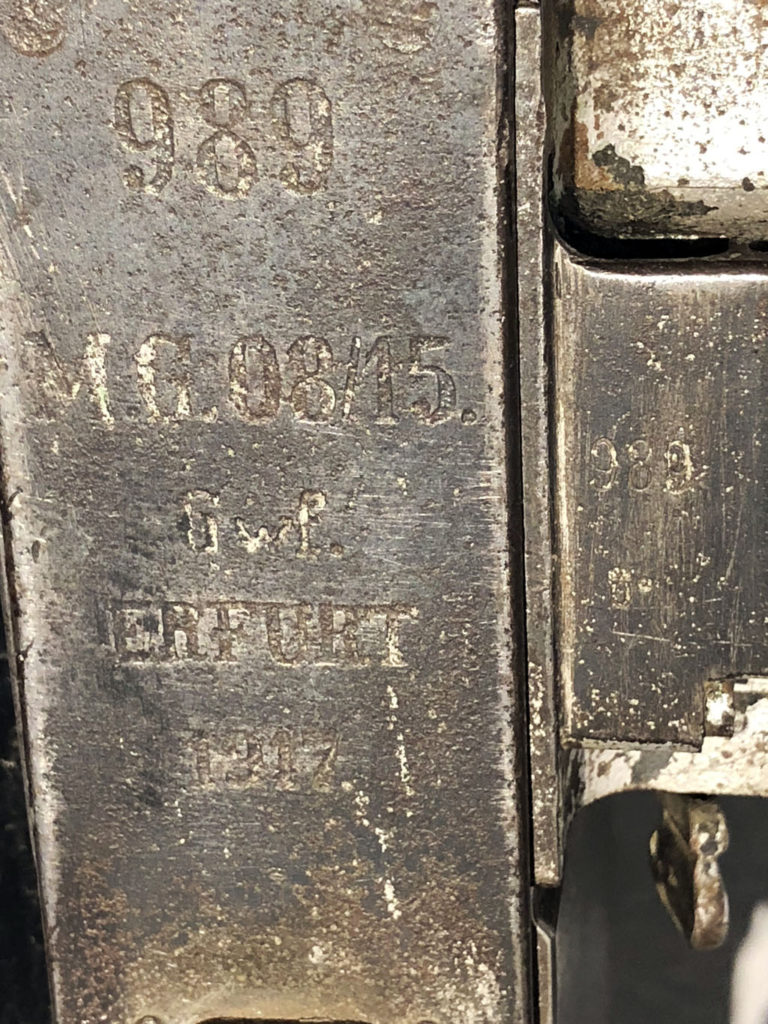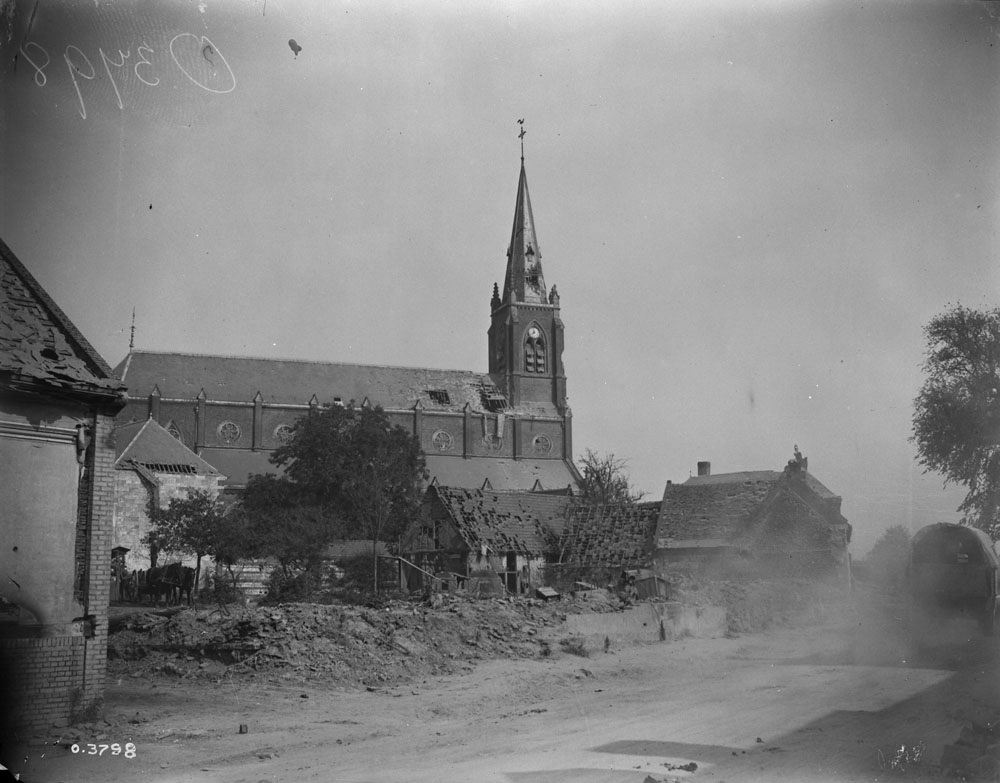
This German Maxim M. G. 08/15, made at ERFURT in 1917, was captured by the 2nd Canadian Mounted Rifles (2 C.M.R.) at Le Quesnoy on August 10th, 1918, on the final day of the Battle of Amiens.
There are two communities named LE QUESNOY in France. Today in 2019, the drive is 1 hour and 23 minutes (119 Km) between the two.
The first LE QUESNOY , where this gun was captured, is near Amiens and is now known as PARVILLERS-LE-QUESNOY.This is where this machine gun was captured.
The second LE QUESNOY is in Eastern France, past Cambrai and near Valenciennes. The second one was captured by New Zealanders in November 1918.
Over 3,800 German World War I machine guns were brought to Canada soon after World War I. They were eventually distributed, along with airplanes, cannons, trench mortars, helmets, rifles etc. across Canada. Many were placed outside as part of war memorials and those suffered from the weather and vandalism. Many were scrapped in World War II metal drives.
This one has survived, albeit missing many parts as is usual. It was sold at auction in February 2019 after being inspected by the R.C.M.P. and approved for sale as “deactivated” (i.e. a non-gun in legal terms). The missing parts were acquired from other war trophy guns that did not have detailed capture histories.
UPDATE: In 2020, M.G. 08/15 ERFURT # 989 went into the collection of the British Columbia Dragoons’ Whizbang Association, the unit which has 2 C.M.R. as a predecessor unit. It will be displayed in the Okanagan Military Museum in Kelowna, B.C., Canada.


“The following morning [August 9th] we marched off, with our band playing “Marseillaise,” moving forward in support three and four miles at a time, frequently under fire from the German heavies, but, as they were firing blindly and as on Aug. 9, 1918 without observation, we had no difficulty in avoiding the shelled areas. That afternoon the 4th and 5th C. M. R. pushed forward and captured La Folies and Bouchoir villages, some thirteen miles from our start of the previous day. At 6 p. m. the brigadier sent for me, and telling me it was necessary to capture LeQuesnoy-en-Santerre, a fortified village about one and a half miles from Bouchoir, in order to insure the following day’s advance, gave orders that the 2nd C. M. R,. was to take it before dark. At that time the battalion was some eight kilometres from Bouchoir, and I pointed out to the Brigadier that it was impossible to issue necessary orders, march eight kilometres, attack over two more and capture a strong position in less than three hours of daylight still remaining, more especially as we had had no opportunity of observing the country to be captured, but that we would endeavor to complete the programme by dawn, and this he agreed to.
At this period our right flank was on the north of the Roye Road, with the left flank of the French resting on the south of the Roye Road somewhat behind our line. As we were to make an attack unsupported at the start on either flank, two batteries of Vickers guns were attached to the battalion to cover and prevent any Boche attack getting in behind us, and in addition, a section of field artillery and three tanks were attached to us, but unfortunately, the tanks broke down before they got to the jumping-off place, and the artillery officer, though definitely told by me the hour of the start and where I would start from, never turned up with his guns. Brigadier General Brutinel of the Corps Motor Machine Guns very kindly furnished us with fifteen motor lorries, with which “A’, “B”, and “C” companies were moved up to Bouchoir, where they debussed under cover of a screen of motorcyclist machine gunners. “D” Company, in support, marched.
At 3 a.m. on the 10th we commenced the advance, the intention being to push as close up to the village as possible by dawn and take it with the bayonet. However, when we got half way we encountered the German outpost, heavily garrisoned, who put up a fierce resistance, and from then on opposition was met with all the way. “B” and “C” Companies, on the left, suffered severely, but were not to be denied and, clearing three lines of trenches with the bayonet, gained a footing in the north end of the village by 6 a.m. “A” Company, on the right, also suffered very heavily from machine gun nests south of the Roye Road, but fought its way forward stubbornly until most of its officers were casualties. Fortunately, about this time, a tank, which had been sent up by the general on hearing the three had broken down, arrived, and on its attention being attracted in that direction, crawled over and pounded the nests out of existence with its Hotchkiss [6 Pounder] guns. By 7 a.m. the village was completely in our hands, with several machine guns and over two hundred prisoners. and we were entrenching on the far side.
Our casualties were heavy; Captain Whitlow and Lieutenant Hanna were killed, and Lieutenants Harris, Palmer, Trees and Williams were wounded, while 45 N. C. O.’s and men were killed and about a hundred and ten wounded. On the other hand, our success enabled the French to come up on our right with practically no opposition, and the same occurred on our left. We had taken over two hundred prisoners, and when we came to count the piles of dead Germans found over two hundred of them also.
The following day the 32nd British Division passed through, and our battalion moved back to a small wood in the rear of Bouchoir, where we stayed resting up and conducting salvage operations until the 16th, when we moved back to Le Quesnel Wood, on relief by the 2nd Canadians. While at Bouchoir and Le Quesnel we received several drafts of reinforcements, as a result of which we left numerically stronger than when we came in.” (from “The 2nd C.M.R. in France and Flanders” pp. 66-67. as quoted by forum member “2nd CMR” at: http://www.cefresearch.ca/phpBB3/viewtopic.php?f=3&t=11398&p=85273&hilit=LE+QUESNOY+capture#p85273
Interestingly a British unit mistakenly claimed to have captured this village. That is also quoted on the CEF Research forum link shown above.

An excellent documentary on the Battle of Amiens, August 8-9-10, 1918 is by Norm Christie on YouTube. I have not provided a direct link as it is not secure. Search YouTube for: FOR KING AND EMPIRE Episode 5 – Final Deadly Battles